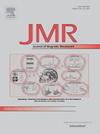Chemical exchange in unstable emulsions
IF 1.9
3区 化学
Q3 BIOCHEMICAL RESEARCH METHODS
引用次数: 0
Abstract
Nuclear magnetic resonance (NMR) is a routine method to study chemical exchange in reactions and molecular rearrangements in solution. However, when it comes to exchange of molecular species in liquid-liquid, two phase systems like in phase-transfer catalysis, the rate becomes a function of the surface area between two phases, which means that only persistent emulsions could be studied with standard equipment. Unstable emulsions, which rapidly demix, require a continuous application of shear forces by stirring. Here, a setup is described with which unstable emulsions can be produced and studied in-situ by solution NMR spectroscopy. The setup provides sufficient torque and spinning frequency for generating an unstable two-phase water/oil mixture by rapid stirring. The pneumatically driven stirrer in the probe head was designed using ideas borrowed from magic angle sample spinning and a prototype was produced by 3D printing. As proof of concept, the dynamics in an aniline water emulsion over the phase boundary are studied by regular exchange spectroscopy NMR experiments.

不稳定乳剂中的化学交换
核磁共振(NMR)是研究反应中的化学交换和溶液中分子重排的常规方法。然而,当涉及到液-液两相体系中分子种类的交换时,就像在相转移催化中一样,速率变成了两相之间表面积的函数,这意味着只有持久乳液才能用标准设备进行研究。不稳定的乳剂会迅速分解,需要通过搅拌持续施加剪切力。本文介绍了一种制备不稳定乳剂的装置,并通过溶液核磁共振光谱法对其进行了原位研究。该装置提供了足够的扭矩和旋转频率,通过快速搅拌产生不稳定的两相水/油混合物。利用魔角纺丝的思路设计了探针头部的气动搅拌装置,并利用3D打印技术制作了样机。为了证明这一概念,我们用常规的核磁共振交换光谱实验研究了苯胺水乳状液在相边界上的动力学。
本文章由计算机程序翻译,如有差异,请以英文原文为准。
求助全文
约1分钟内获得全文
求助全文
来源期刊
CiteScore
3.80
自引率
13.60%
发文量
150
审稿时长
69 days
期刊介绍:
The Journal of Magnetic Resonance presents original technical and scientific papers in all aspects of magnetic resonance, including nuclear magnetic resonance spectroscopy (NMR) of solids and liquids, electron spin/paramagnetic resonance (EPR), in vivo magnetic resonance imaging (MRI) and spectroscopy (MRS), nuclear quadrupole resonance (NQR) and magnetic resonance phenomena at nearly zero fields or in combination with optics. The Journal''s main aims include deepening the physical principles underlying all these spectroscopies, publishing significant theoretical and experimental results leading to spectral and spatial progress in these areas, and opening new MR-based applications in chemistry, biology and medicine. The Journal also seeks descriptions of novel apparatuses, new experimental protocols, and new procedures of data analysis and interpretation - including computational and quantum-mechanical methods - capable of advancing MR spectroscopy and imaging.

 求助内容:
求助内容: 应助结果提醒方式:
应助结果提醒方式:


